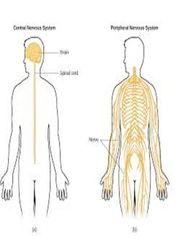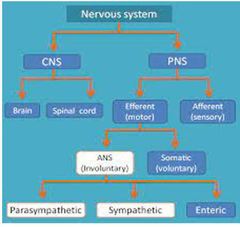![]()
![]()
![]()
Use LEFT and RIGHT arrow keys to navigate between flashcards;
Use UP and DOWN arrow keys to flip the card;
H to show hint;
A reads text to speech;
50 Cards in this Set
- Front
- Back
|
The CNS runs from the brain down to the spinal cord while the PNS consists of nerves and ganglion outside the brain and spinal cord. T/f |

True |
|
|
___________ is primarily meant for interpretation and further processing of in-coming neural signals. |
The CNS |
|
|
Both in-coming and outgoing signals to PNS take different routes and referred to as the ________ and _________ signals respectively. |

Afferent and Efferent |
|
|
_____________ are chemical structured proteins that receive and transduce signals which may further be integrated into biological/ human system. |
Receptors |
|
|
What are the Types of Receptor? |
Cell surface receptors •Ion channel-linked •G-protein linked •Enzyme linked Internal receptors |
|
|
The nerve fibres are connected directly to one another. T/f |
False- they are not connected The synaptic gap is present between two adjacent neurones. |
|
|
__________ are released by the nerve to facilitate the propagation of impulse across the synapse. |
Neurotransmitters |
|
|
Somatic sensation is subdivided into two namely: |
Exteroreceptive: These are concerned with sensations originating from the body surfaces Proprioceptive: sensation are those relating physical states of the body. |
|
|
__________ are type of sensation is primarily originated from the visceral organ. |
Visceral sensation |
|
|
___________are type of sensation that originate from the deep tissues. |
Deep sensation |
|
|
Nerve fibres are basicaly of two types: |
1. A-fibres (they are also myelinated fibres). 2. C-fibres (they are the nonmyelinated fibres) |
|
|
The A fibres are further classified based on the _________ and _________ at which the neural signals are transmitted. |
Diameter & Speed |
|
|
The bigger the diameter of A-fibre the _______ the neural transmission. |
Faster |
|
|
The fibres conveying neural messages from the nociceptors are myelinated. T/f |
False - Unmyelinated |
|
|
What type of nerve fibers are involved in conveying pain?
|

Aδ-fibers are also the smallest myelinated nerves and have a relatively fast conduction velocity of 30 m/s. The diameter of Aδ-fibers is about 2–5 µm, and is responsive towards short-lasting and pricking pain. |
|
|
What are the types of sensory pathways we have |
Dorsal column- medial lemniscal pathway Anterolateral pathway |
|
|
___________ pathway is primarily made up of myelinated nerve fibres through which impulses are transmitted at faster rate within the range of 30-110 m/s |
Dorsal column-medial lemniscal |
|
|
____________ has a high degree of spatial orientation of the nerve fibre |
Dorsal column- medial lemniscal pathway |
|
|
The dorsal system is somewhat limited to mechanoreceptive sensations like touch, vibration, positional movement from the joints, pressure intensity. T/f |
True |
|
|
___________ pathway is utilized by neural signals from pain sensation, tickle, itch, sexual sensation, thermal sensatio |
Anterolateral |
|
|
The transmitted nerve impulse enters theCNS (spinal cord) through the ________ root |
Dorsal root |
|
|
The nerve impulse follows the medialbranch and then turns upward in the dorsalcolumn and further pass uninterruptedly tothe dorsal medulla (which also contains thecuneate and gracile nuclei).. T/f |

True |
|
|
Second order neurones which decussate immediately to the opposite side of the brain stem and are further projected upward and terminate on the thalamic sensory relay centre called the ‘_______________ |
Ventrobasal complex. |
|
|
The third-order nerve fibres project to the somatic sensory area located in the post central gyrus of the cerebral cortex. T/f |
True |
|
|
The third-order nerve fibres project to the somatic sensory area located in the post central gyrus of the cerebral cortex. T/f |
True |
|
|
The anterolateral fibres cross immediately in the anterior commissure of the cord to the opposite side and turn upward toward the brain by way of spinothalamic tract to the thalamus (the ventrobasal complex).The signals are then transmitted to the somatosensory cortex. T/f |

True |
|
|
ANS is being driven by visceral reflex responses. The ANS is further divided into : |

Parasympathetic nervous system (PNS) and Sympathetic nervous system (SNS). |
|
|
Echch ANS pathway from the cord to the stimulated tissue comprises two neurons mention them: |
Pre-ganglionic neurons and Post-ganglionic neurons |
|
|
The pre-ganglionic secretion in both PNS and SNS is the ___________. Meanwhile, the postganglionic secretion in SNS is ______________. |
Acetylcholine Noradrenaline |
|
|
PNS stimulation takes its source from _________ while the SNS originates from the _______________ |
Cranial nerves Spinal cord at the thoracic region. |
|
|
The nervous system is a network and does not function in isolation. T/f |
True |
|
|
___________ is majorly responsible for voluntary activities while ___________ is meant for the involuntary ones |
Somatic stimulation Visceral stimulation |
|
|
Major neurotransmitter as involved in PNS is _________ while ________ is involved with SNS. |
Acetylcholine Noradrenaline |
|
|
The brain cortical areas meant for the interpretation of somatic sensation are marked _____________ with respect to Broadmann’s classification. |

Area 3, 1, 2 NB: There exist connections between the area responsible for interpretation of sensory signal and the primary motor area |
|
|
___________ area is primarily concerned with the execution of skilled or voluntary movement. |
The motor area |
|
|
In the _______________ occurs the involvementof other areas of the brain inorder to bring about checksand balance as well ascomparation of the intendedmovement with the actualmovement e.g cerebellum etc. |
Motor Area |
|
|
The motor pathway from the cerebral cortex to the spinal cord is called __________________ |
The ‘Corticospinal tract’ or ‘Pyramidal tract’. |
|
|
The similar accessory motor pathways which are meant to modulate the motor signals in the pyramidal tract. These pathways are called _____________ |
Extrapyramidal pathway’. |
|

Study |
Done |
|
|
Mention the Extrapyramidal tracts |
•Vestibulospinal tract •Reticulospinal tract •Rubrospinal tract •Tectospinal tract •Corticorubrospinal tract •Corticorubral tract |
|
|
_____________ Tract Alter tone and change the position of the limbs and head with the goal of supporting posture and maintaining balance of the body and head |
Extrapyramidal Tracts |
|
|
_____________ tracts inhibits the extensor and stimulates the flexor muscles of the trunk and fore limbs |
Extrapyramidal Tract |
|
|
_______________ Controls muscle tone in the flexor group of muscles e |
Extrapyramidal Tract |
|
|
The brain stem consists of __________, ________ and the _________. |

Pons Medulla Midbrain |
|
|
The brain stem is the downward projection of spinal cord. T/f |
False- upward |
|
|
The vestibular and reticular nuclei as situated in the brain stem is primarily involved with the body movement and maintenance of equilibrium through excitation/inhibition of antigravity muscles. T/f |
True |
|
|
The activation ___________ nuclei antagonizes the excitatory signals from the pontine reticular nuclei |
Medulary reticular nuclei |
|
|
The activation of __________ nuclei further excites the antigravity muscles and helps to maintain stability. |
Vestibular nuclei |
|
|
Corticospinal tract is the main pathway for the motor signals. T/f |
True |
|
|
_____________pathway is considered an accessory motor pathway |
Extrapyramidal |

